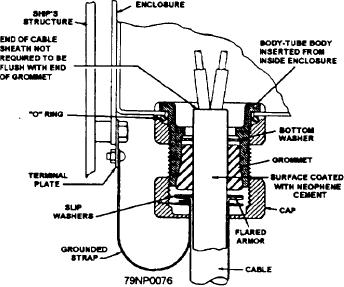
stuffing tube, should have a minimum height of 9 inches
removed. The solid plug is inserted in place of the
and a maximum height of 18 inches. If the height
grommet, but the slip washers are left in the tube (fig.
exceeds 12 inches, a brace is necessary to ensure rigid
2-28, view B).
support. If the installation of kickpipes is required in
A grounded installation that provides for cable entry
nonwatertight decks, a conduit bushing may be used in
into an enclosure equipped with a nylon stuffing tube is
place of the stuffing tube.
shown in figure 2-29. This type of installation is
When three or more cables pass through a deck in a
required only when radio interference tests indicate that
single group, riser boxes must be used to provide
additional grounding is necessary within electronic
protection against mechanical damage. Stuffing tubes
spaces. In this case, the cable armor is flared and
are mounted in the top of riser boxes required for topside
trimmed to the outside diameter of the slip washers.
weather-deck applications. For cable passage through
One end of the ground strap, inserted through the cap
watertight decks inside a vessel, the riser box may cover
and one washer, is flared and trimmed to the outside
the stuffing tubes if it is fitted with an access plate of
diameter of the washers. Contact between the armor
expanded metal or perforated sheet metal.
and the strap is maintained by pressure of the capon the
slip washers and the rubber grommet.
Aboard ship, watertight integrity is vital. Just one
Wireways
improper cable installation could endanger the entire
ship. For example, if one THFA-4 cable (0.812 inch in
Before you install new cable, survey the area to see
diameter) were to be replaced by the newer LSTSGA-4
if there are spare cables in existing wireways and spare
cable (0.449 inch in diameter), but the fittings passing
stuffing tubes that can be used in the new installation.
through a watertight bulkhead were not changed to the
The cable run must meet the following criteria:
proper size, the result might be two flooded spaces if a
collision or enemy hit occurs.
Be located so that damage from battle will be
minimized
Deck Risers
Be located so physical and electrical interference
with other equipment and cables will be avoided
Where one or two cables pass through a deck in a
single group, kickpipes are provided to protect the
Be located so that maximum dissipation of
cables against mechanical damage. Steel pipes are used
internally generated heat will occur.
with steel decks, and aluminum pipes with aluminum
and wooden decks. Inside edges on the ends of the pipe
Where practical, you should route vital cables along
and the inside wall of the pipe must be free of burrs to
the inboard side of beams or other structural members
prevent chafing of the cable. Kickpipes, including the
to afford maximum protection against damage by flying
splinters or machine gun straffing. Only when
necessary, should cables be run on the exterior of the
deckhouse or similar structures above the main deck.
Avoid installing cable in locations subject to
excessive heat, if possible. Never install cables adjacent
to machinery, piping, or other hot surfaces having an
exposed surface temperature greater than 150F. In
general, cables should not be installed where they may
be subjected to excessive moisture.
CABLE SUPPORTS
To prevent unnecessary stress and strain on cables,
cable supports or straps are used. Types of cable
supports are the single cable strap, cable rack, and
Figure 2-29.--Nylon stuffing tube grounded installation.
modular cable supports.
2-27

